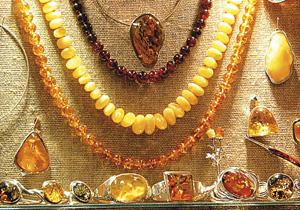Mystery, magic, glamour and the quest for the golden grail…these aspects have all fuelled the flame for humankind’s age-old search and love for amber. From ancient times, this organic gem was prized by Greeks and Romans as ‘petrified sunlight’, as they believed it to possess the warming, healing and life-giving powers of the sun. According to Greek mythology, amber originated from the tears shed by the Heliades sisters (daughters of Helios, the Sun God) over the death of their brother Phaethon, who fell to earth with his horse-drawn sun chariot. The weeping sisters transformed into poplar trees on the bank of the Eridanus River, and their tears became ‘glistening drops of amber’.
The true origin of Baltic amber is less lyrical but equally fascinating. Between 35 to 70 million years ago, the region that is now the Baltic Sea and Scandinavia was covered with a massive prehistoric coniferous forest. As the climate became warmer the conifer trees – a type of now-extinct pine tree – started to exude large amounts of resin to protect themselves against insects and fungus. Over time, the changing sea levels made amber settle on the bottom of the sea and liquid resins caught in the sediments were fossilised into amber. The dead tree trunks were washed southward to the coastal area between the mouth of the Vistula River (near the Polish port of Gdańsk ) and the Sambia Peninsula (now located in Russia’s Kaliningrad area). The hardened lumps of resin, the rough rock that is now knows as amber, drifted to the seashore in massive quantities where people simply collected them in baskets. This region is estimated to provide 90% of all gem-quality amber in the world, with deposits in Poland alone totaling approximately 650,000 tons.
Wide Variation
The word ‘amber’ has long applied mainly to the fossilised tree sap found the the Baltic and North Sea regions, although larger deposits of this soft gem – ranging from 20 to 120 million years old – have also been discovered in the Dominican Republic, Mexico, Lebanon, Siberia, Burma, China, Italy and Romania. Amber that is less than 10 million years old and has not gone through the complete fossil evolution is called copal, a white-coloured stone that is found predominantly in Columbia, New Zealand and some African countries.
In Poland, amber most frequently washes up on the shore line after a large storm. The waves drive amber-trapped seaweed onto the beaches where amber collectors can easily scoop them up in the tide line. It’s found in a luscious array of hues – with over 256 identified colour varieties worldwide – ranging from shades of yellows and browns to greens and reds. The most expensive and scarcest ‘cherry’ amber is a deep purple, while the classic Baltic amber is usually called ‘cognac’ or ‘honey’, but there’s also amber in green, brown and bone-white – created by microscopic gas bubbles – found in the Baltic region. This mineral is not only valued for its colour palette, but also for its degree of transparency that can vary from clear to cloudy, and its cleanliness. The clear and translucent versions range from light yellow to dark maroonish yellow, while cloudy types (filled with tiny air bubbles) come in all colours and can range from semi-transparent to opaque.The chemical composition of amber also determines its quality, value and and use. The active ingredient in Baltic amber is succinic acid that is present in a range from three to eight percent (the highest level in any amber found around the globe); the acid, which is a medical substance, was discovered by German Nobel-prize winning scientist Robert Koch in 1886. Koch was the first to confirm that amber’s succinic acid has a positive influence on the human organism, from improving immunity to balancing acid levels and strengthening the body. Other than its dazzling range of colours, amber is also a remarkable material that delineates evolutionary history with a variety of once-living inclusions preserved in the amber itself. In other words, each piece of amber tells a unique story, since the gem trapped insects, flowers, leaves, moss, pine needles, flies, beetles, ants, spiders and even lizards millions of years ago when the oozing resin was still viscid. Scientists have been able to identify 3,000 species of prehistoric insects and over 214 plant types in amber, varying in size from a few millimeters to four centimeters. The visibility, size, rarity, placement and scientific value of the inclusion all determine the value of an individual piece of amber.
Peculiar Powers
Amber’s beauty, ease of processing and mysterious powers made it a sought-after stone for decoration and ornamental goods for primitive inhabitants of the Baltic Sea region. Archaeological evidence shows that the use of amber dates back to 35-45,000 years ago, when the stones were tooled into precious talismans and pendants for protection against dangers during hunting journeys. Depending on various cults, some amulets were crafted in the form of sun-like round discs decorated with dots and other geometrical shapes, while others were shaped to look like animals, deities and hero figures. The ancient Romans also believed in the protective powers of amber, using it to decorate the gladiator arena as well as burying their dead with a piece of amber to ward of evil spirits in the afterlife.
Throughout the centuries, Baltic amber has also been said to possess medicinal properties. When worn on the skin, this ‘healing stone’ releases healing oils believed to have calming, healing and uplifting effects. Its tension-relieving effects have long been used in European cultures to help children with teething pain. Beyond pain palliating, folk medicine utilised amber as a remedy for swollen glands, fever, goiters and different liver and kidney illnesses. Ground amber powder mixed with honey was used against unclear vision, amber powder dissolved in water cured sore throats and crouching over the smoke of burning amber was believe to heal hemorrhoids. Some even thought it could cure depression, nervousness and curb suicidal tendencies. Later, through the 17th and 18th centuries, doctors recommended amberremedies for patients suffering from lung, heart and rheumatic diseases and skin disorders. Today, homeopathic pharmacies in Poland still sell a variety of amber ointments and powders that help against arthritis, neuralgic pains – and even hangovers.
New Age practitioners believe amber opens and charges the third chakra, the so-called ‘solar plexus’. On a physical level, the warm mineral imbues the body with the power of the sun and by soaking up negative energy and sending it upwards, moods are balanced and mental clarity provided. It’s also believed that when worn near a chakra center, amber instills intellectual focus.
Trade Trail
As soon as this non-precious stone starting washing up on the shores of Northern European countries (including territories of present-day Lithuania, Latvia, Estonia, Poland, Denmark, Norway and Sweden), it became a prized possession that brought faraway nations into contact with one another. Tradeways between East and West were established as early as the second millennium B.C. during the so called ‘New Stone Age’. By about 1500 B.C. the network of roads and waterways in eastern and central Europe had linked together to create the ‘Amber Road’. This ancient amber trade route ran from the Baltic Sea, down the Vistula, Elbe and Danube River all the way through Italy, Greece, the Black Sea and Egypt, and connected with the Silk Road that led to obscure Asian areas. Intensive trade in amber continued throughout reign of the Roman Empire until the third century A.D., when ongoing wars shattered the trade route. Poland and the Baltic region eventually came under the control of the Order of the Knights of the Cross (a.k.a. The Teutonic Knights) in 1264 and they took absolute control over the manufacturing and trading of amber.
By order of the Knights, all amber had to be given to the appointed official of a given region, and anyone caught trying to hide or steal the stone would be sentenced to death. Amber trade saw a resurgence in Poland after the Polish-Lithuanian forces defeated the Teutonic Order in 1410’s Battle of Grunwald. The ageold amber-bearing city of Gdańsk was incorporated into the country in 1466 and the first amber craftsman’s guild was established in 1477. Other historically important amber guilds in Poland were founded in the coastal cities of Elbląg, Kołobrzeg, Koszalin and Słupsk. With the rapid development of amber guilds, specialists and goldsmiths re-established connections with the historic trade partners and forged contemporary channels of commerce.
Gdańsk: Amber Capital
Bound with the inexhaustible treasure of the Baltic Sea, Gdańsk became the centre of amber craft as early as the 15th century. Following the downfall of the Teutonic Knights, guilds and craft organisations multiplied in numbers and artistic amber craft developed rapidly in the town. By the 16th and 17th centuries, with the Polish-Lithuanian Commonwealth in its strongest phase, amber crafting had reached an apex of creative development and prestige, turning from use in mainly devotional items to ordinary objects and lavish objets d’art. Amber craftsmen in both Gdańsk and Königsberg (modern-day Kaliningrad) used amber to make an assortment of kitchen utensils (glasses, bottles and cutlery), frames, candlesticks, boxes, chessboards and interior design trinkets for nobility, clergymen and other well-to-do citizens. Special one-off amber artefacts were also given as gifts in diplomacy for European rulers, religious figures and celebrities. Anna Jagiellon, the Queen of Poland and Grand Duchess of Lithuania during the second half of the 16th century, for example, received a heart-shaped pendant with the portrait of Hungarian King Stefan Bathory, made by a Gdańsk-based amber master.
Political turmoil and economic hardship saw the beginning of the backsliding in the ‘heyday of amber craft’ during the mid-18th century. The two world wars effectively wiped out the Polish and European amber craft, destroying every single amber workshop in Gdańsk. While the 1960s and 1970s spurred a resurgence of amber trade and affairs, it wasn’t until the collapse of the Communist system in 1989 that the new era of the business of amber really began. Today, the city boasts hundreds of amber shops, studios and galleries – several of which are stationed on a narrow, cobble-stone Mariacka Street – showcasing hand-made necklaces, rings, bracelets, brooches, earrings, colliers, rosaries, key chains and carvings. At present, local amber craftsmen are hard at work designing and building a 120 m2 amber alter in the city’s St. Bridget church, which will incorporate over six tons of the golden stone.
The city has also become a respected center of amber-related scientific research, with the main offices of the International Association of Amber Masters and the National Amber Chamber of Commerce both based in Gdańsk. Moreover, the city’s main university features the world’s first and only Department of Amber.
Anna J. Kutor


